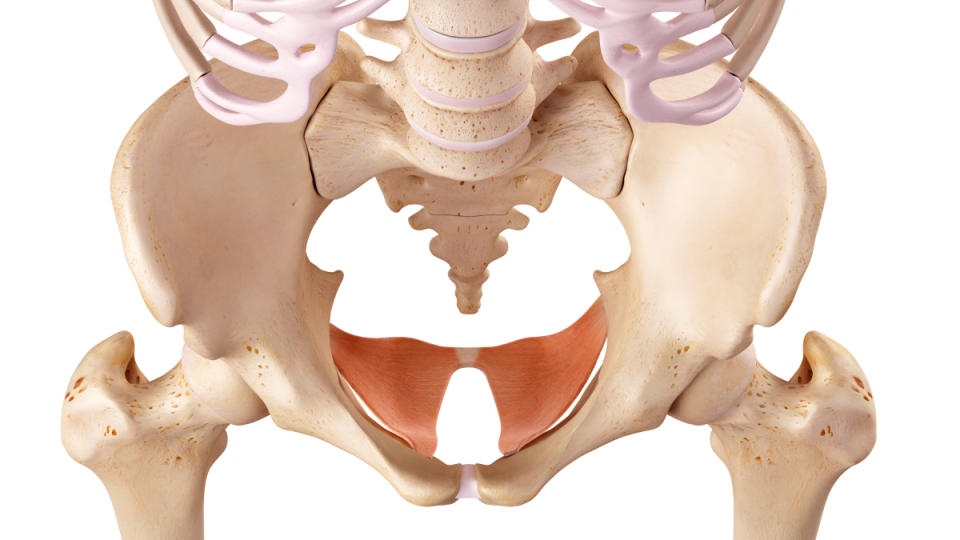Pelvic Pain and Bladder Leaks Can Signal a Hypertonic Pelvic Floor — And Kegels Can Make Things Worse
Your pelvic floor muscles likely aren't top of mind in your everyday life. But they play a surprisingly important role in your health. They regulate bladder and bowel control, plus help stabilize bones like your hips and spine. But with so much responsibility, these muscles are susceptible to overactivity and tension — something doctors call hypertonic pelvic floor.
While it doesn’t have the name recognition of conditions like pelvic prolapse or overactive bladder, it is quite common. In fact, about 1 in 10 people develop hypertonic pelvic floor. But what exactly does that mean, and why it’s so important to treat? We asked pelvic health experts to share the signs and symptoms, plus their best home remedies.
What is a hypertonic pelvic floor?
As its name suggests, hypertonic pelvic floor affects the muscles in your pelvic area, says Dawn Ericsson, MD, a Yale-trained, board-certified obstetrician-gynecologist and the chief medical officer at AgeRejuvenation. “These muscles support the structures located in this area of the body, like the bladder, lower intestinal tract, uterus, ovaries and vaginal canal or prostate,” she explains.
A hypertonic pelvic floor increases the “tone” of these muscles, or the amount of tension they hold. It forces the pelvic floor into “a state of constant contraction or spasm,” Dr. Ericsson says. “These muscles have difficulty relaxing,” which can affect the function of other organs and soft tissues nearby. Everyone has tight pelvic floor muscles occasionally, but if the problem becomes chronic, it increases your risk of more severe problems down the line.

Symptoms of hypertonic pelvic floor
Since hypertonic pelvic floor has similar symptoms to overactive bladder (OAB) and pelvic inflammatory disease, it can be difficult to diagnose. However, there are some telltale signs to watch out for.
“When the pelvic floor muscles are hypertonic [or overactive/tense], people can experience pelvic pain — sometimes directly in the genitals or anus,” says Jessica Reale, DPT, a Duke University-trained, board-certified Doctor of Physical Therapy specializing in women’s pelvic health. The pain might also extend to the abdomen, hips, sacroiliac (SI) joint, buttocks or lower back. "And this is all coming from the pelvic floor!” Reale says.
She adds that tension in the pelvic floor muscles can also cause other symptoms, including:
Painful sex
Constipation (difficulty emptying the bowels)
Urinary frequency, urgency and/or leakage
Inability to achieve orgasm
Some people have many of these symptoms at once, while others just have one or two, Reale adds.
Who's at risk of hypertonic pelvic floor?
Hypertonic pelvic floor affects people of all ages and genders, but certain things could increase your risk. Courtney Virden, a professional pelvic floor trainer and the inventor of the iCore METHOD, an exercise program designed to help restore pelvic floor dysfunction, says those risks include tearing of the perineum (the delicate skin between the anus and genitals), chronic stress and anxiety.
Reale adds that women are more likely to experience a hypertonic pelvic floor because of “scars related to childbirth, hysterectomies and other pelvic surgeries.” Other factors that contribute to a hypertonic pelvic floor include:
Constipation
Injury or trauma
Muscular dysfunction
Inflammation of the pelvic organs
Polycystic ovarian syndrome (PCOS) and endometriosis

Inside Creative House/Getty
Kegels can worsen hypertonic pelvic floor
Another surprising cause of hypertonic pelvic floor? Kegel exercises. “Kegels are often considered the go-to exercise for the pelvic floor, but they can actually overtighten those muscles,” Virden explains. “For those who already have a hypertonic pelvic floor, Kegel exercises often make existing symptoms worse and can even create new symptoms.”
Reale agrees, noting that it's incredibly common. "I often teach professionals that if a patient has worsened symptoms with kegels, overactivity/hypertonicity should be strongly suspected,” she says.
8 home remedies for hypertonic pelvic floor
Considering the complexity of the pelvic floor and its many responsibilities, you might assume that a hypertonic pelvic floor is something difficult to treat. Thankfully, that isn’t the case. The experts we spoke to provided several strategies that may be able to provide lasting relief.
1. Try guided meditation
When you're stressed, your body enters "fight or flight” mode. This increases your heart rate and blood pressure, causes your muscles to tense up and releases adrenaline, a hormone that makes you feel alert. These physiological responses help protect you from pain or injury. But they can also exacerbate the tension in your pelvic floor and make hypertonic pelvic floor symptoms worse.
Setting aside time each day for R&R can make a big difference. “I love recommending [guided meditation] for my patients with hypertonic pelvic floor,” Reale says. “I find that connecting with tension in the body as a whole can be very helpful in releasing tension in the pelvis.”
Elizabeth D’Annunzio Shah, DPT, PT, OCS, MTC, a doctor of physical therapy who specializes in pelvic floor dysfunction, echoes these sentiments. “I like guided meditations especially because they promote body awareness," she says. "Oftentimes, patients don’t realize they are clenching [specific muscles]. Meditations not only help identify that, but also help you break the clenching habit through regular, routine practice.”
New to meditation? Reale recommends two apps that can walk you through the process: Insight Timer and Headspace. Or try a free meditation designed specifically for hypertonic pelvic floor, such as the video below.
2. Relax with a hot water bottle
Another easy way to calm pelvic floor tension? Heat therapy. For this, you’ll need a heating pad or a hot water bottle. Simply lie back and “apply the warm pad or water bottle on top of your underwear over your pelvic region for 15 to 20 minutes at a time as needed for relief,” Dr. Ericsson says. Increasing the temperature around your pelvic floor muscles boosts circulation to the area, soothes tight muscles and easing pain.
Proof it works: A study in Female Pelvic Medicine and Reconstructive Surgery found that a pelvic floor rehabilitation program including heating pad use, relaxation techniques and other therapies provided a nonsurgical alternative for those with pelvic floor dysfunction.
3. Take a deep breath
Deep breathing has been used for centuries to relax both your mind and body. It works by increasing blood oxygen levels and reducing muscle tension. It may even activate the vagus nerve, a key part of the parasympathetic nervous system responsible for stress relief. Similarly, Reale says it can “facilitate lengthening and letting go of tension in the pelvic floor.” (Click through for vagus nerve exercises that tame stress.)
Here’s how to do it. “Take a long, slow inhale in, letting go of tension in your belly while allowing your belly to lift," Reale advises. "While you inhale, allow your pelvic floor muscles to lengthen. Next, exhale while keeping your muscles relaxed. Repeat this breathing pattern slowly for 2 to 3 minutes in the morning and evening.”
Need extra guidance? The video below provides step-by-step instructions:
4. Add on 'pelvic floor drops'
“This exercise aims to help the pelvic floor muscles lengthen and relax,” Reale explains. “And it can be paired with diaphragmatic breathing, too.”
To get start, “let go of any tension in your pelvic floor muscles, allowing them to drop — almost like starting a urine stream,” Reale says. (Note: This isn’t pushing or bearing down, just letting go). “Then, while keeping [your pelvic floor muscles lengthened] perform slow, diaphragmatic breathing as described above for 2 to 3 breaths. Repeat this pattern during the 2 to 3 minutes you’re working on diaphragmatic breathing.”
For more step-by-step support, check out the video below:
5. Consider curcumin
Remember how we said inflammation of the pelvic organs can contribute to hypertonic pelvic floor? If your symptoms continue after trying other home remedies, you might benefit from an anti-inflammatory supplement such as curcumin, the active ingredient in the spice turmeric. (Click through to see more turmeric benefits for women.)
In fact, Dr. Ericsson recommends “curcumin, fish oil, vitamin D, bromelain or vitamin C, as they can provide some relief.” However, she advises talking to your doctor first.
Several studies have linked anti-inflammatory supplements to pelvic pain relief. One in the International Journal of Molecular Sciences found that curcumin effectively relieved pelvic inflammation. Another in the American Journal of Clinical Nutrition concluded that vitamin D supplementation noticeably reduced pelvic pain, as did fish oil supplementation.

6. When you gotta go, go
“Rule of thumb is to go to the bathroom when you feel the urge,” says Caryn McAllister, DPT, a doctor of physical therapy who specializes in pelvic floor rehabilitation. “Don’t hold it. You can end up training your body to tighten up when it needs to relax to pee and poop. Our bodies are meant to go, and ‘holding it’ during long car rides or because you don’t want to use a public restroom can lead to this condition.”
7. Do the 'Happy Baby'
If you've ever done yoga or pilates, you might have heard of the Happy Baby stretch. Reale says it “helps facilitate lengthening and relaxation of the pelvic floor muscles,” which makes it ideal for addressing a hypertonic pelvic floor."
First, lie on your back and bring your knees to your chest. Then, reach your arms between your legs and grab your ankles or shins, allowing your knees to drop open. If you're less flexible or have stiff hips, Reale says you can hold your thighs instead.
Relax your muscles. “Then take slow breaths, directing each breath to lengthen and open your pelvic floor muscles," Reale says. "Hold this position for five breaths, performing the exercise once in the morning and once in the evening.” (The benefits of yoga don't stop there. Click through to learn how chair yoga eased one woman's chronic pain.)
For a visual how-to, check out the video below:
8. Use a percussive massage gun
“Targeting the supporting muscle groups around your pelvic floor with a massage gun can help those with a hypertonic pelvic floor find relief,” Shah notes. “I recommend gently targeting your groin muscles and buttocks.”
No percussive massage gun on hand? No problem! Shah says using a foam roller can provide similar benefits. Check out the video below for beginner-friendly instructions:
Related: “Pelvic Floor Massage Stopped My Embarrassing Bladder Leaks — For Good!”
What to do if hypertonic pelvic floor problems persist
Learning to relax your pelvic floor muscles can go a long way toward relieving pelvic floor tension. But it's not always enough to provide lasting relief. For that, you might need pelvic floor physical therapy.
“We have to get to the root of why the muscles are responding with tension, and this requires a comprehensive exam and treatment approach,” Reale says. “Often, [pelvic floor physical therapy] includes manual therapy — specific techniques aimed at improving mobility in the pelvic floor muscles. We also prescribe specific exercises and work with patients to optimize their bowel, bladder and sexual health habits.”
Most importantly, remember that the condition isn’t something you have to live with. “Hypertonic pelvic floor happens at all ages and stages of life,” Shah says. “Know that it’s definitely something that can get better. [Working with a qualified professional] can help you get back to yourself.”
For more ways to keep your pelvic floor healthy and block bladder bothers:
“Pelvic Floor Massage Stopped My Embarrassing Bladder Leaks — For Good!”
Goodbye, Bladder Leaks! Doctors Reveal the Best Urinary Incontinence Remedies
This content is not a substitute for professional medical advice or diagnosis. Always consult your physician before pursuing any treatment plan.

